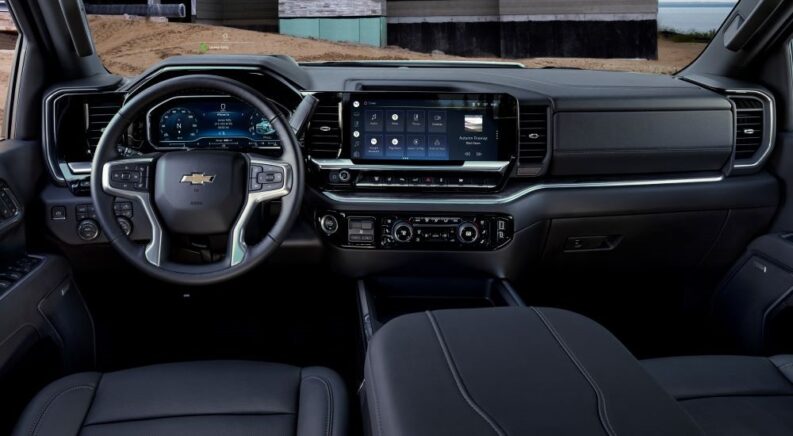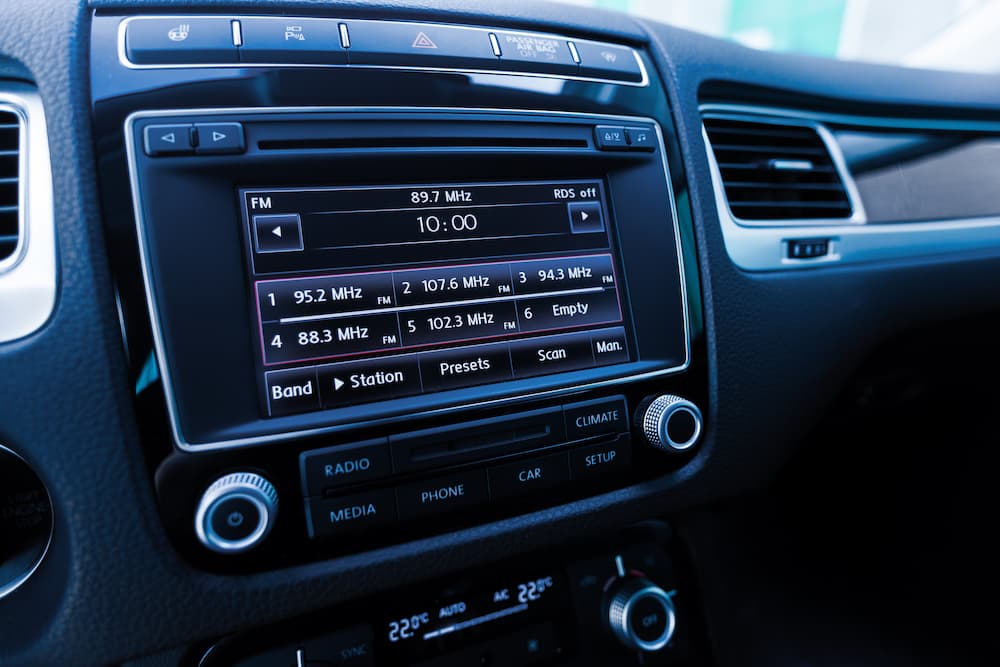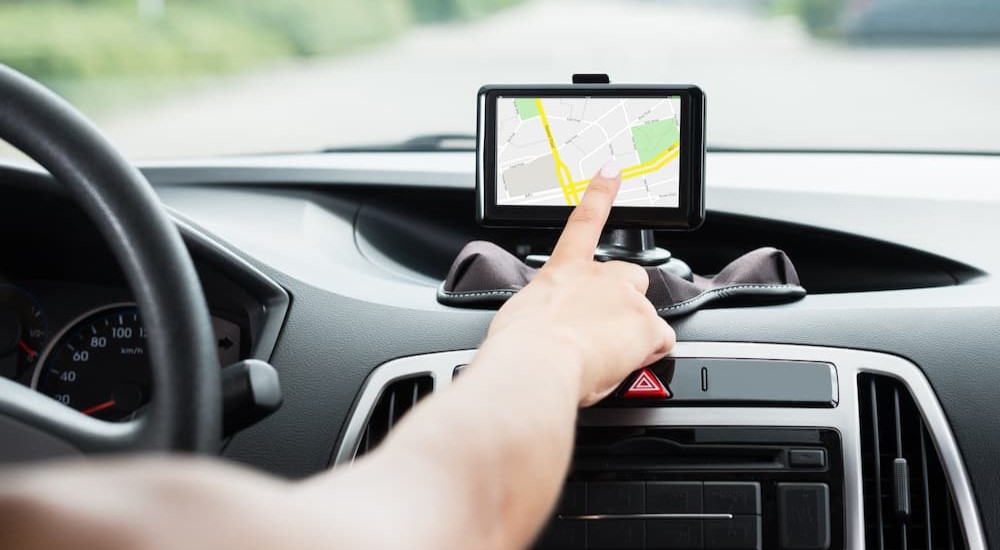Today’s drivers would be lost without their digital distractions, which make long morning commutes and family road trips noticeably more bearable. Fortunately, modern vehicles have come a long way from the early days of automotive history when you’d be lucky to find anything more than a static-filled AM radio mounted to the dashboard. Now we’re spoiled for choice, with in-vehicle entertainment systems that cover all the bases. Looking for something to listen to? Press a button and you’ll enjoy instant access to your favorite media from any number of streaming services. Need to find the closest Chevy Silverado for sale near Middletown, PA? The inlaid GPS is already feeding you turn-by-turn directions—even alerting you to accidents or traffic jams and suggesting alternate routes. In some well-appointed vehicles, the infotainment system can even help you to make a dinner reservation, buy a movie ticket, or order takeout. Let’s see an AM radio do that.
As our infotainment has expanded in functionality, it’s also grown in size. While drivers were once satisfied with a full-color touchscreen display of any kind, the dashboard has become the new battlefield for automakers, with each looking to up the ante in functionality and size. The fourth-generation Chevy Silverado embodies this trend more than most. While the award-winning full-size pickup was limited to a relatively modest seven- or eight-inch infotainment screen until recently, a 2022 refresh saw the Silverado bestowed with a massive 13.4-inch screen that’s among the largest in the industry. This landscape-oriented screen is larger than those of the average laptop, giving drivers an easily visible—and navigable—surface that adds to this pickup’s reputation for convenience while improving driver safety. Let’s take a closer look at the evolution of in-vehicle infotainment technology and see how the 2023 Silverado is going all-in.
Music to a Driver’s Ears
In-vehicle entertainment has been a cornerstone of the driving experience since the first radio was installed in 1930. That was the year that Paul Galvin, an ambitious inventor with a background in batteries and early AC radio sets, retrofitted his Studebaker with an AM radio. Given the size and relative complexity of radios at the time, this was no small task. Radios were not only bulky but also highly sensitive and thirsty for power. Galvin had to find space to mount the radio and antenna, figure out a way to eliminate electrical interference from the vehicle, and install a secondary battery under the seats to supply the whole rig with power. It was a forward-thinking project but also a potentially lucrative one: in the early part of the 20th century, radio was king. Until televisions made their way into homes in the mid-1940s, the AM band was the nation’s clearinghouse for news and entertainment, with almost 600 stations occupying the airwaves by 1922.
Retailing for $130—a steep $2,300 in today’s dollars—the FT71 radio was an instant hit, rocketing Galvin to success and leading to the formation of a new company that used an auto-minded “motor” prefix fused with “ola” as a means of evoking the most popular phonograph brand of the day, the Victrola. Motorola was born and would soon grow into a major force in the electronics industry, with its hands in everything from car radios and transistors to televisions and—eventually—cell phones. The car radio would continue to evolve through the subsequent decades, becoming smaller, lighter, and more user-friendly while integrating new features like the ability to program preset radio stations.
The next big innovation in the in-vehicle entertainment space was a bit of a flash in the pan, but it deserves mention anyway. In the 1950s, vinyl record players were the only way—aside from the radio, television, or live performances—to enjoy your favorite tunes. None of these options were available for on-the-go listening, inspiring the head of CBS Laboratories to develop the first in-car record players. The company partnered with Chrysler to install the system on a limited number of models, and—while it was an intriguing novelty—practical concerns stood in the way of widespread adoption. The main issue came down to vibrations: record players hate them, and cars love to produce them. While they did attempt to tweak the design with shock-absorbing springs and other methods, in-vehicle record players never really took off and were discontinued from the Chrysler options list within a few short years.
Ultimately, magnetic tape-based audio would take hold as the medium of choice for the auto industry. Ford teamed up with Motorola to introduce the first in-vehicle eight-track player in 1964, although the format would eventually be replaced with smaller cassette tapes over the ’70s and ’80s. By the ’90s, CD players began to replace the humble cassette player—but now even those have been phased out in many vehicles, as drivers opt for Bluetooth-connected phones, USB ports, and infotainment system-based streaming apps.
Finding the Way
Unlike audio systems, in-vehicle displays are a much more recent development with some of the earliest options not arriving on the scene until the 1980s. There was one notable exception in the luxurious Aston Martin Lagonda, which included a digital screen displaying the car’s speed, fuel, temperature, RPM, and current time. It was a pretty basic system but it still came at a steep price. Display technology would come to the masses a decade later when Buick introduced the 1986 Riviera. Known as the Graphic Control Center (GCC), this nine-inch screen allowed drivers to tweak some 91 functions, from diagnostics and gauges to climate controls, odometers, and, of course, radio.
While the GCC still relied on CRT technology, it had one major advantage over the Aston Martin system: a touchscreen display. The three-by-four-inch system drastically reduced the number of knobs, switches, and other controls Buick had to cram into the dashboard, providing a cleaner, more modern-looking interior. That said, the system did have its drawbacks. Not only did the simplified display require lots of menu diving that prevented drivers from focusing on the road, it almost emitted a loud beep every time something was pressed. Drivers didn’t love the sound of RD-D2 riding shotgun, and the system was nixed within a few short years.
The CRT display approach would soon be replaced with LED systems which were not only smaller and less expensive but also boasted higher resolution, giving automakers a chance to experiment with the technology and slowly work it into everything from odometers and radio tuners to climate controls and more. LCD technology continued to improve throughout the late ’80s and early ’90s, with brighter, higher-resolution screens slowly finding their way into vehicles.
As in-vehicle displays became more practical and gained in resolution, new applications were explored, and—naturally—GPS was one of the first choices. Technology that gives drivers the ability to seamlessly navigate from points A to B is a bit of a no-brainer when it comes to motor vehicles, but it took a long time for in-car GPS to get off the ground. The first in-vehicle navigation system—decades before the actual GPS would be invented—came in the form of the Iter Avto device, which slowly scrolled through a spooled-up physical map in time with the vehicle. Fifty years later, Honda would unveil the Gyro-Cator unit, a dashboard-mounted “inertial navigation system” that kept track of the vehicle’s location using a small helium gas gyroscope like those found on many Cold War-era fighter planes. Cassette tape and CD-ROM-based navigation systems would see limited use in the late ’80s but were held back by limited storage space. The Etak Navigator, for example, required drivers to switch between four cassettes depending on their location—and that was just within the Los Angeles city limits.
In-vehicle GPS tech finally found a foothold in 1990 with the debut of the Mazda Eunos Cosmo. This top-of-the-line model was packed with cutting-edge tech, with its built-in GPS system giving drivers unprecedented accuracy and convenience on a full-color display. While the Unos Cosmos was limited to the futuristic land of Japan, American automakers were not far behind, with General Motors introducing their GuideStar system for the 1995 Oldsmobile 88 series. This system relied on map cartridges for navigation but was still seen as a major improvement over previous offerings.
True GPS functionality would hit the market in 1997 when Alpine rolled out the CVA-1005, which relied on a combination of CD-ROM-based maps and GPS satellites. Until the year 2000, the US government was actively repressing GPS functionality in the name of national security. While early GPS systems worked for most applications, they often lacked pinpoint accuracy that is critical when trying to figure out which turn to take. Companies like Garmin TomTom would grow to dominate the early GPS market, perfecting in-vehicle GPS systems into the reliable, handy products we grew up with, though many of these standalone GPS devices have since been replaced by built-in alternatives or smartphone apps.
The Modern Day
For a driver who grew up with little more than AM radios and LCD clock displays, the Silverado’s 13.4-inch infotainment system must seem like something straight out of science fiction. Offered as a standard feature on the Silverado 1500 LT, RST, LT Trail Boss, ZR2, LTZ, and High Country trims, the mammoth display is a driver’s one-stop shop for navigation, entertainment, performance metrics, advanced driver assistance systems (ADAS) and more. The system can run the new Google Automotive software, which integrates some of the tech company’s most beloved applications into the Silverado’s cabin. From Google Maps to the Play Store and Google Assistant, you’ll never be hurting for directions or entertainment options when you’re behind the wheel of the Silverado. The Silverado also features a built-in WiFi hotspot, giving everyone on board access to a fast, reliable connection that will make long road trips more enjoyable than ever.
Those looking to connect to their smartphones will enjoy seamless integration thanks to wireless Apple CarPlay and Android Auto support. These systems essentially turn the 13.4-inch display into a control surface for your iPhone or Android product, allowing drivers to stream their favorite music, access contacts, make calls, and send messages while on the go. Before you start to preemptively write us a ticket for distracted driving, the system’s built-in voice control allows you to compose texts without ever taking your hands off the wheel.
The infotainment display is divided into two sections, with the left side displaying digital buttons and controls while the right is dedicated to maps or GPS directions, and this can even be customized to fit a driver’s personal preferences. This infotainment system strikes a pleasant balance between digital convenience and analog control, with a healthy mix of screen-based and physical buttons and knobs that make interacting with the system a convenient—and safe—experience.
In some cases, we’ve noticed automakers going a little hog-wild when it comes to these touchscreen displays, forcing every function onto the screen and forcing drivers to perform time-consuming menu-diving maneuvers to access simple functions like AC controls or music volume. Chevy has avoided such pitfalls through clever design and the use of such an expansive display, improving overall safety while making for a much less frustrating experience.
In addition to the 13.4-inch display, the 2023 Silverado also boasts a 12.3-inch configurable digital instrument cluster. Replacing the analog gauges of old, this full-color display provides a convenient look at any relevant metrics a driver might be curious about. From speed and mileage to temperature, driving mode, fuel economy, and more, this digital instrument cluster is the perfect complement to the 13.4-inch display, freeing the touchscreen to focus on its infotainment offerings. The digital instrument cluster also provides the perfect interface for GM’s semi-autonomous Super Cruise driver assist system, which takes over many of the more mundane driving duties. The Super Cruise system—which comes standard on the High Country trim level and above—can be easily monitored from the digital instrument cluster, giving drivers the ability to set the following distance and speed and control other ADAS systems.
With a class-leading 13.4-inch display packed with impressive functionality, the Silverado’s infotainment system goes a long way in illustrating just how far in-vehicle technology has come in the last century. To a driver who once dropped $2,300 on Motorola’s early AM radio, the Silverado’s cutting-edge infotainment system would probably be seen as nothing less than a miracle. From the early days of bulky AM radios that required their own separate battery to the short-lived in-vehicle record players and early scroll- and cassette-based GPS systems, it’s sure been a weird, wacky road.
In many ways, some of these early efforts were too ambitious, striking a solid idea but too limited by the tools of their era to deliver on those promises. As technology has improved—and consumer demands have evolved—today’s in-vehicle technology has become a primary focus in modern vehicle design. The 2023 Silverado has doubled down on the idea of a tech-heavy interior, bringing a new level of convenience and fun to a traditionally working-class sector and instilling no small amount of jealousy in our gadget-deprived ancestors.







